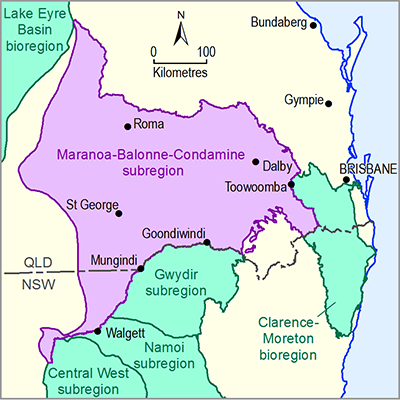- Home
- Assessments
- Bioregional Assessment Program
- Maranoa-Balonne-Condamine subregion
- 3-4 Impact and risk analysis for the Maranoa-Balonne-Condamine subregion
- 3.5 Impacts on and risks to water-dependent assets
Summary
Potential impacts on and risks to water-dependent assets due to additional coal resource development were analysed by intersecting assets with the zone of potential hydrological change. Water-dependent assets that occur within or across the zone need to be considered further, while assets that do not occur in the zone are considered very unlikely (less than 5% chance) to experience potential impacts and are ‘ruled out’ from further consideration. Of the 2660 water-dependent assets nominated by the community for the subregion, 2495 are very unlikely to be impacted because they experience less than 0.2 m drawdown due to additional coal resource development.
The 115 ecological water-dependent assets in the zone of potential hydrological change include 12 assets classified in the ‘Groundwater feature (subsurface)’ subgroup and 29 assets in the ‘Surface water feature’ subgroup. None of the 882 water-dependent assets in the ‘Floodplain’, ‘Lake, reservoir, lagoon or estuary’, ‘Marsh, sedgeland, bog, spring or soak’ or ‘Waterhole, pool, rock pool or billabong’ classes are in the zone of potential hydrological change. This includes the 177 springs assessed in Section 3 .4.
There are 74 water-dependent assets in the ‘Vegetation’ subgroup in the zone of potential hydrological change, including 33 assets in the ‘Groundwater-dependent ecosystem’ class, 39 assets in the ‘Habitat (potential species distribution)’ class and 2 riparian vegetation assets. This includes the potential habitats of 4 threatened ecological communities and 18 species listed under the Commonwealth’s Environment Protection and Biodiversity Conservation Act 1999 and an additional 11 species and 6 endangered regional ecosystems listed under Queensland’s Nature Conservation Act 1992. Water-dependent assets listed as protected reserves, parks or bird habitats are not found within the zone.
There is at least a 5% chance that 163 bores experience greater than 0.2 m drawdown in the source aquifer due to additional coal resource development. The 163 bores are part of 13 economic water-dependent assets comprising 7 water access rights and 6 basic water rights (stock and domestic). Of these 163 bores, it is very likely (greater than 95% chance) that additional drawdown exceeds 5 m in 17 bores located near the proposed New Acland Stage 3 coal mine pits, including 5 bores that access water from the near-surface aquifer and 12 bores that access water from the deeper Walloon Coal Measures.
The Barakula State Forest, near Miles in Queensland, is the sole sociocultural water-dependent asset located in the zone of potential hydrological change. It is very likely that 21 km2 or 0.7% of the 3092 km2 forest experiences more than 0.2 m of drawdown due to additional coal resource development.

Product Finalisation date
- 3.1 Overview
- 3.2 Methods
- 3.3 Potential hydrological changes
- 3.4 Impacts on and risks to landscape classes
- 3.4.1 Overview
- 3.4.2 Landscape classes that are unlikely to be impacted
- 3.4.3 'Floodplain or lowland riverine (including non-GAB GDEs)' landscape group
- 3.4.4 'GAB GDEs (riverine, springs, floodplain or non-floodplain)' landscape group
- 3.4.5 'Non-floodplain or upland riverine (including non-GAB GDEs)' landscape group
- 3.4.6 'Human-modified' landscape group
- References
- Datasets
- 3.5 Impacts on and risks to water-dependent assets
- 3.6 Commentary for coal resource developments that are not modelled
- 3.7 Conclusion
- Citation
- Acknowledgements
- Contributors to the Technical Programme
- About this technical product
